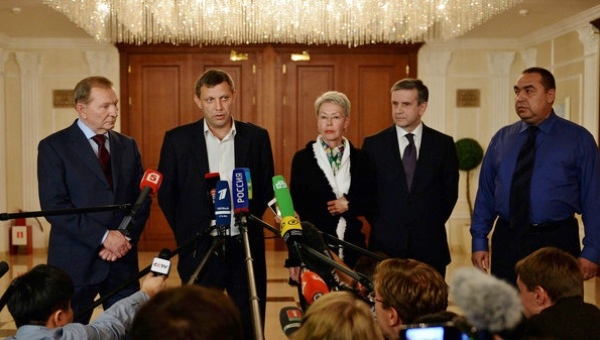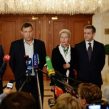
Armistice Opens Way to Russian Partition of Ukraine’s Donetsk and Luhansk Provinces
Publication: Eurasia Daily Monitor Volume: 11 Issue: 168
By:

On September 20 in Minsk, negotiators from Ukraine, Russia, the Organization for Security and Cooperation in Europe (OSCE)—which together constitute the Tripartite Contact Group—as well as the Russia-installed Donetsk and Luhansk leaders finalized an agreement on the main elements of an armistice in the ongoing conflict.
This document has the status of a “memorandum of implementation” pursuant to the September 5 ceasefire protocol, which was negotiated as a framework document (see EDM, September 10, 11). Both documents open with purely declarative references to presidents Petro Poroshenko’s and Vladimir Putin’s respective peace plans, released in August. But the protocol and the memorandum in themselves have no connection to those presidential proposals. Just like the protocol, so the memorandum exists only in the Russian language, without officially authorized translations (osce.org, accessed September 21, 24).
The memorandum is essentially a military document, although it is fraught with political implications (see below). This document is not yet a full-fledged or binding agreement (“the sides have reached an understanding […] on a bilateral cessation of the use of weapons”). It marks the beginning of a separation of combatant forces in the field. A mutually accepted contact line is now emerging between them, to correspond with a demarcation line between Ukrainian-controlled and Russian-controlled territories in Ukraine’s Donetsk and Luhansk provinces. The military line of contact (separation of forces) is defined as that which existed in the field as of September 19. The memorandum does not mention corrections to this line, although corrections (whether negotiated or fought over) are ongoing in the field.
Under this document, the use of all types of weapons, as well as any offensive actions, are “prohibited.” This allows Ukraine to continue defending the encircled Donetsk Airport and the threatened city of Mariupil (in Russian—Mariupol) from recurring attacks. The memorandum institutes a ceasefire zone (“zone of the cessation of the use of weapons”), also referenced as a security zone, 30 kilometers in width, measuring 15 kilometers on either side of the military line of contact. This concept is similar to South Ossetia 1992–2008, where the “security zone” extending on either side of the line of contact had bitten off a portion of Georgian-controlled territory.
All weapons with a caliber of more than 100 millimeters shall be evacuated from the ceasefire zone (weapons below that caliber are allowed in this zone, however). In addition, heavy artillery and multiple rocket launchers with ranges of 16–120 kilometers are to be evacuated to distances that put them out of range of the ceasefire zone entirely. This move takes Ukrainian artillery out of range of the two conurbations of Donetsk and Luhansk.
However, Russia’s weapons systems can continue threatening Ukrainian positions from Russia’s own territory, for perpetual “coercion to peace.” Disconcertingly, the memorandum does not mention any restrictions on battle tanks in the ceasefire zone or outside it. Apart from that, no heavy weaponry or combat vehicles may be stationed in the Novoazovsk-Komsomolske area. The Ukrainian intention here is to shield Mariupil, but the provision is weak because the banned items are not specified. Existing minefields and mined obstacles are to be dismantled in the ceasefire zone, and new ones may not be installed.
Combat aircraft and “foreign” unmanned aerial vehicles (UAV) are “prohibited” from overflying the ceasefire zone and the military line of contact. “Foreign” is not defined, and an exception is made for UAVs to be used by the OSCE`s Monitoring Mission (under Russian-imposed limitations—see below). Further under this document, the OSCE shall divide the ceasefire zone into sectors, whose number and “borders [sic]” shall be defined by agreement. This opens the door for the Donetsk and Luhansk authorities to be accepted de facto as the OSCE’s interlocutors, just as in South Ossetia during 1992–2008 and in Transnistria from 1992 to date.
The September 20 memorandum’s final point (number 9) envisages the “evacuation of all foreign armed formations, military vehicles [“tekhnika,” a term that includes tanks and other armored vehicles], as well as gunmen [“boyeviki”] and mercenaries, from the territory of Ukraine, under monitoring by the OSCE.”
This final point is recognizably Ukrainian in origin and terminology. The September 5 ceasefire protocol contained an almost identically worded clause (point 10 out of 12). While that document referenced “unlawful armed formations,” however, the September 20 document references “foreign” ones. This implies de facto acceptance of the Donetsk-Luhansk-flagged forces, which originated in Russia.




